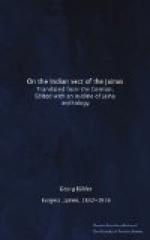On the other hand we possess two documents from the middle of the next century which prove that they advanced into south-eastern India as far as Kali[.n]ga. These are the inscriptions at Kha[n.][d.]agiri in Orissa, of the great King Kharavela and his first wife, who governed the east coast of India from the year 152 to 165 of the Maurya era that is, in the first half of second century B.C.
The larger inscription, unfortunately very much disfigured, contains an account of the life of Kharavela from his childhood till the thirteenth year of his reign. It begins with an appeal to the Arhat and Siddha, which corresponds to the beginning of the five-fold form of homage still used among the Jainas, and mentions the building of temples in honour of the Arhat as well as an image of the first Jina, which was taken away by a hostile king. The second and smaller inscription asserts that Kharavela’s wife caused a cave to be prepared for the ascetics of Kalinga, “who believed on the Arhat.” [Footnote: The meaning of these inscriptions, which were formerly believed to be Buddhist, was first made clear by Dr. Bhangvanlal’s Indraji’s careful discussion in the Actes du Vlieme Congres Internat. des Orientalistes Sect. Ary. pp. 135-159. H; first recognised the true names of the King Kharavela and his predecessors and shewed that Kharavela and his wife were patrons of the Jainas. We have to thank him for the information that the inscription contains a date in the Maurya Era. I have thoroughly discussed his excellent article in the Oesterreichischen Monatsschrift, Bd. X, S. 231 ff. and have there given my reasons for differing from him on an important point, namely, the date of the beginning of the Maurya Era, which, according to his view begins with the conquest of Kali[.n]ga by A[’s]oka about 255 B. C. Even yet I find it impossible to accept that the expression, “in the hundred and sixty fifth year of the era of the Maurya Kings”, can mean anything else than that 164 years have passed between the thirteenth year of the rule of Kharavela and the anointing of the first Maurya King Chandrugupta. Unfortunately it is impossible to fix the year of the latter occurrence, or to say more than that it took place between the years 322 and 312 B.C. The date given in Kharavela’s inscription cannot therefore be more closely fixed than that it lies between 156 and 147 B.C. I now add to my former remarks—that appeals to the Arhat and Siddha appear also in Jaina inscriptions from Mathura and may be taken as a certain mark of the sect. Thus it is worthy of note that even in Hiuen Tsiang’s time, (Beal, Si-yu-ki, Vol. II, p. 205) Kalinga was one of the chief seats of the Jainas.]




